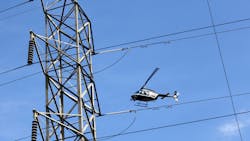Ohio Edison Uses Helicopters, Infrared for HV Inspections
To keep power flowing safely and reliably through the upcoming winter months, proactive aerial inspections along nearly 800 miles of 345-kV transmission lines were recently completed throughout Ohio Edison's service area using infrared and ultraviolet (IR/UV) technology.
Completed every four years in conjunction with American Transmission Systems Incorporated, a FirstEnergy Corp., transmission subsidiary, IR/UV patrols help prevent future power outages by detecting early-stage and often invisible equipment issues within transmission substations and on high-voltage power lines that cannot be observed during regular visual inspections. These comprehensive inspections complement annual aerial patrols that identify visible concerns, like overgrown trees, broken poles or birds nesting on electrical equipment.
"The transmission system is the first line of defense in preventing power outages because it supplies the electricity that flows into substations and along power lines to every single one of our customers," said Ed Shuttleworth, president of FirstEnergy's Ohio operations. "Think of the power system like a sprinkler. The garden hose that supplies water is a transmission line and the sprinkler is the substation. Each stream of water coming out of the sprinkler hits different parts of the lawn, just like individual power lines feed electricity to various neighborhoods."
An IR/UV inspection is performed at low-flying patrol speeds between 25 and 35 mph, using an infrared and ultraviolet camera mounted on the bottom of the helicopter. The onboard thermographer uses the camera to view the electrical equipment through infrared and ultraviolet spectrums to identify any sources of overheated components or voltage issues.
The infrared technology shows heat on a color scale, with brighter colors or "hot spots" indicating areas that could need repairs. The thermal images can identify equipment issues such as loose connections, corrosion and load imbalances, while ultraviolet technology detects electrical discharge along a power line caused by issues like rusted hardware and cracked insulators. The combination of both technologies is beneficial because it provides a wider range of detection. Any issues identified during the inspections are addressed to prevent service disruptions and costly repairs down the road.
"Helicopters provide a view of electrical equipment that we can't get from the ground, allowing inspection of miles of power lines in a single day," said Shuttleworth. "However, on-the-ground inspections are still necessary and underway to ensure our neighborhood power lines and equipment are ready to meet the high demand for electricity when customers crank up their heaters to stay comfortable this winter."
The IR/UV aerial inspections in Ohio Edison's territory began in mid-August and were completed in September. Visual aerial inspections also were completed along nearly 4000 miles of 138-kV and 69-kV lines in 2021, with approximately 700 more miles of high-voltage lines to be inspected by the end of the year.
